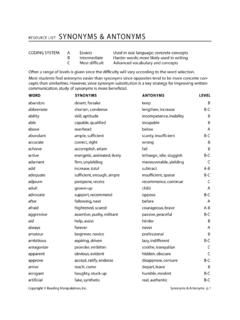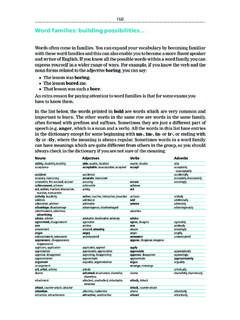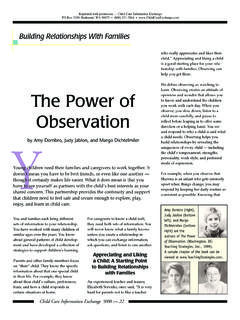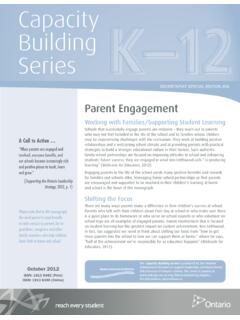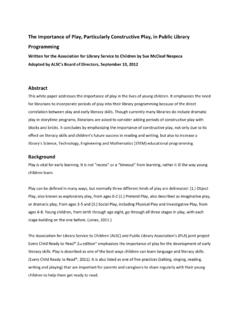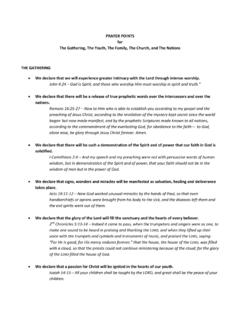Transcription of SLV WORD FAMILIES - readskill.com
1 PRODUCT CONTENTS17 cover-weight sheets (5 colors)8 pages of teacher informationCOPYRIGHT READING MANIPULATIVESAll rights reserved. Printed in the United States ofAmerica. No part of these materials may be used or reproduced in any form or by any means, orstored in a retrieval system, without prior writtenpermission of the publisher. Making copies of anypart of these materials for any purpose other thanyour personal use is a violation of United Statescopyright DEVELOPMENTAll sets or cards in Reading Manipulatives products are students are introduced to the skills and shown how to do theactivity, they work independently. The individualized materials canbe used for seatwork or stations. Students work on needed skills,and teachers are freed for guide includes a brief summary of the skills that aretargeted by this product. For many skills, additional teaching aidscan be downloaded from the resource section of our web site( ).
2 ASSEMBLY & PACKAGINGR eading Manipulatives materials are commercially laminated butmust be cut and packaged prior to use. Preparation tips are given,and coding of the sets is FAMILIES can be stored in zipper bags. Small food storagebags from the grocery store can be used. Heavier 4 mil zipper bagscan be found online. 4 x 4 is a good size for word FAMILIES . Sincethere are 91 word FAMILIES , you might prefer other means ofstorage. This guide includes suggestions for organizing andpackaging the word Manipulatives, Inc. 1725 E. Mountain View Rd. Phoenix, AZ 85020 888-997-2448 877-997-7685 (F) WORD FAMILIESPRODUCT CODE:250 In order to work with any of the Reading Manipulatives decoding or blending products, students mustknow short and long vowel phonemes and spelling patterns. These skills are necessary in order toanalyze and decode the rimes, or bases. Use the following strategies to teach or review the phonemes and spelling 1 TEACH PHONEMESF irst make sure that students can identify and produce the vowelphonemes.
3 Teach the short vowel phonemes in isolation using soundassociations to help students learn and remember these challengingphonemes. The examples to the right are used in the ReadingManipulatives Phoneme Songs & Blending program. Short vowelsposters are available separately, or they can be downloaded from ourweb site. You can also listen to the songs vowels are easier to master. Remind students that the longvowels say their names. Long u is somewhat troublesome since it has two sounds (as in fuse[fyooz] and plume[ploom]). Work with the easier vowels first. Students tend to predict the long u sound without any difficulty after they become familiar with short and long vowel phonemes and 2 TEACH SHORT/LONG VOWEL PATTERNSOnce students can identify and make the short and long sounds, teach vowel spelling patterns. Simplifythe basic concepts being taught. Teach this rule for short/long vowel patterns:When there is one vowel in the word (at the beginning or the middle), the vowel is there are two vowels, the first vowel is long and the second is Manipulatives flip strips demonstrates this rule.
4 Students readthe short vowel word. When the second vowel is flipped over, the word isthen read with a long one-syllable words follow this rule, making it an excellent buildingblock for beginning readers. This concept is taught before the introduction ofvariant vowels, which are obvious 3 DECODE words THAT FOLLOW THE PATTERNSOnce students know short/long vowel sounds and spelling patterns, they can use these to decode orencode words . With ample practice, application becomes Manipulatives offers products that provide decoding practice. One uses matching look at the word to determine if the vowel phoneme is short (one vowel) or long (two vowels).Then they read the word and match it to a picture. Another has scrambled sentences that contain wordsthat follow the SLV patterns. The sentences can be one of the first reading experiences for decode the words , arrange them into sentences, and match the illustrations.
5 If you do not have these materials, make up activities that include words following the web site has resources that will help you, including words and directions for making flip would be particularly helpful as an activity to precede introducing SLV word FAMILIES . They drillspelling patterns and lay a groundwork for blending, which is a difficult task for beginning VOWELS & SPELLING PATTERNSa)e)i)o)u)hopebestastPhonetic blending is the ability to join phonemes in a smooth enough manner to approximate apronunciation that enables identification of the word. Blending is a challenging skill, but if teachersmodel blending and separating sounds and provide plentiful practice, students develop blendingproficiency. Research indicates that students who spend greater than average amounts of time onblending score higher than average reading test scores through the second grade. Reading the words in the word FAMILIES should be done on a one-to-one basis, so consider the useof volunteers or peer tutors.
6 It is important that all who are listening to students read the word familiesare familiar with the short/long vowel phonemes and spelling , they should also be taught some blending strategies so they can assist students asnecessary. These are the steps to follow: Figure out the vowel sound based on the vowel spelling Read the graphemic base, or rime (vowel to end of word) Blend the initial sound (phoneme or blend) to the baseWord FAMILIES are the easiest method for developing blending proficiency because rhyming facilitates the BLENDING METHODOLOGIESR eading Manipulatives has two other types of blending manipulatives. The different methodologies thatthey employ make them suited to varied objectives in classroom Blending is a close-ended blending activity, making it the bestblending activity for center use. Students work through two difficulty levels inthis series. The 26 sets afford extensive practice blending onsets and set has 3 initial sounds (8 per star) and 27 rimes that follow short/longvowel patterns.
7 All common phonemic bases are covered. Five variant vowelbases (underlined to signal their occurrence) are also included. These extrapoints can be added to give students additional practice and Blending drills this critical skill in an open-ended 20 sets are grouped by digraphs, L-blends, R-blends, and S-blends. Eachset has 4 to 7 beginning sounds and 32 to 35 bases that follow the short/long vowelpatterns or contain variant vowel phonemes (underlined to signal their occurrence). Thefinal set in each group contains 3-letter blends. Students line up the blends or they sound out each base, blend it to the initial sounds until they find a word, andplace it there. Since a base may blend to more than one beginning sound, answer keysare not possible. Once students complete the activities, they should read the words thatthey have formed to a teacher or another BLENDING CONCEPTS INTO ENCODING ACTIVITIESS tudents are focusing on phonetic elements and spellings, so consider integrating blending concepts(onsets and rimes) with writing and spelling programs.
8 Teach students to remove the rimes of spellingwords and change the onsets. Ask them to write rhyming words for words in spelling lists. If the groupcan handle it, expect them to be able to spell any word that rhymes with list words on spelling must segment the base of a spelling word ( , make =ake). Dictate multiple words forthem to spell that have this base (bake, cake, rake, shake, take, wake). After practicing this skill for sometime, include rhyming words on spelling & PACKAGINGA rotary trimmer is ideal for cutting laminated materials. A paper cutter will suffice, but rotary trimmers are moreaccurate and easier to use. If your school does not have one,rotary trimmers can be purchased at art and office supplystores or at discount warehouse clubs. Copy centers oftenhave a rotary trimmer available for customer the sheets of word FAMILIES into horizontal stripsusing a trimmer. Scissors can then be used to cut the rimesand onsets apart since they can be cut with a single are left aligned and onsets are right aligned.
9 Eachvowel is in a different color. The first letter of a code is thevowel, and then each word family for that vowel has adifferent this task to sort as you cut to save yourselftime. There are 5 to 6 rows that each have a word bottom row or two are additional onsets that go withthe word FAMILIES on the OPTIONSC onsider how you prefer to package the word FAMILIES . Zipper bags may not be the best option due to thenumber of word FAMILIES (91). Additionally, since this is not a student-centered set of manipulatives,teachers will choose to use the word FAMILIES in various them presorted by each vowel. This is easy to do since each vowel is printed on a may want to further divide these by short and long vowels, but keep in mind that if they aremixed, students must apply the vowel-pattern rule to figure out the vowel phoneme. This demands thatstudents think about spelling following are some possibilities for keeping the word FAMILIES separated.
10 Put a small rubber band around each sorted group (look in the hair accessories at a store for these). Place each word family in a bag or envelope. Most 4 mil bags are sold in quantities of 100 if youwant to use zipper FAMILIES RESOURCE LISTA resource list of word FAMILIES follows. The list has bases containing short and long vowels. It is acomprehensive list that includes word FAMILIES and words not included in this product. The number inparentheses following the base, or rime, is the code for that word family. The words with asterisks arenot included in this product. In some cases, there were simply too many words . These selection criteriafor the onsets were applied. Onsets containing three-phoneme blends or silent letters were not used. Advanced vocabulary words were avoided when easier options were list should help teachers see the various spelling patterns, as well as frequency of resource list can be utilized for selecting words to use in spelling & MANAGING MATERIALSWord family noted in parentheses.


